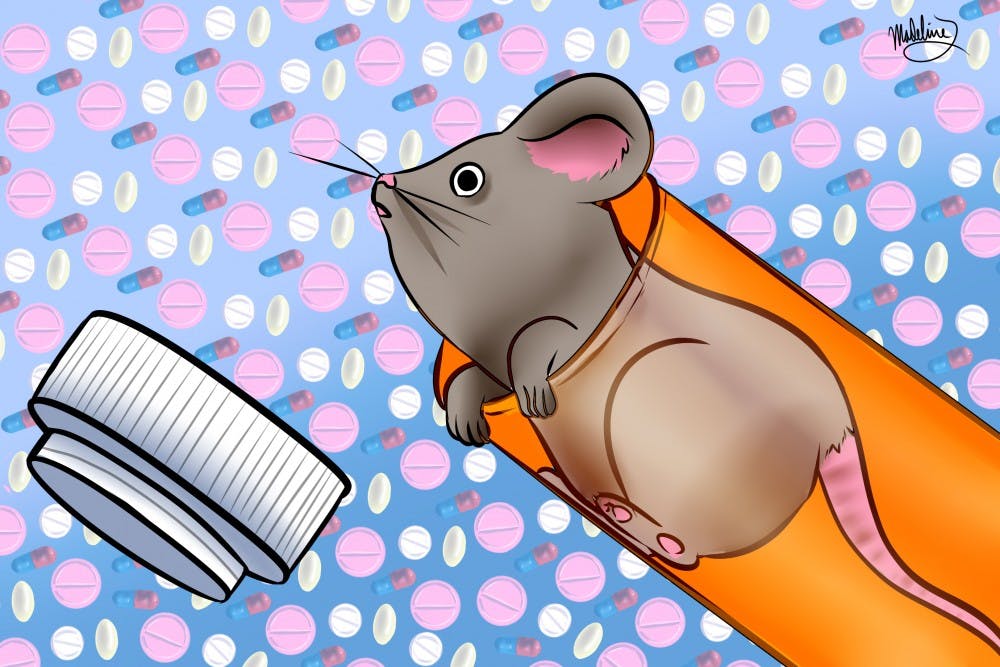Today in the U.S., addiction is as big an issue as ever. Millions are addicted to prescription opioids, many of which are obtained legally.
In light of the ongoing crisis, the need for addiction treatments is high. Several laboratories at ASU are learning more about what causes addiction, as well as studying potential pharmaceutical treatments.
The Olive Lab, headed by associate professor of psychology Foster Olive, focuses on the changes in the brain that promote dependency.
"Olive's lab studies the neurochemical basis of addiction," Seven Tomek, behavioral neuroscience doctoral student in the Olive Lab, said. "We have looked at methamphetamine, bath salts, cocaine, and we look at relapse, ways to attenuate addiction, and different things that are happening with brain circuitry."
Upwards of 23.5 million people suffer from drug addiction in the U.S. In 2012, doctors wrote 259 million prescriptions for painkillers, nearly all of which have a high potential for abuse.
According to the National Institutes of Health, about 2.1 million Americans suffer from opioid addiction, many of whom may be victims of the opioid epidemic.
Tomek is looking at ways to mediate the effects heroin has on behavior. Her current study uses a restraint model, in which one rat is trapped in a locked chamber, and another rat is free. Invariably, the free rat will unlock the restrainer to release the trapped rat. However, if a rat is addicted to heroin, this is not the case.
"One rat will be locked in a restrainer and the other will open a door and release him, and we establish a saving behavior," Tomek said. "Then the rats are given opiates, and after they get addicted, they stop saving their friend. So it’s an empathetic model that’s altered by heroin. What we are trying to do is use chemogenetics to make them save their friend again."
Chemogenetics, in the most basic terms, is a process in which molecules are used to stimulate specific neurons.
Tomek is studying a region of the brain called the insular cortex, which is a part the limbic system, constituting a major area of research for addiction. Specifically, the insular cortex modulates empathy and drug craving, among other functions.
“If you stimulate the insula with chemogenetics, it will basically restore functioning of the insula. It’s like a volume control for empathy, fear and emotions."
The data retrieved so far looks promising.
While scientists from the Olive lab study the structural and molecular basis of addiction, researchers from the Neisewander lab, headed by School of Life Sciences professor Janet Neisewander, peer through a multidisciplinary lens.
The Neisewander lab studies the molecular, behavioral and pharmacological, or drug-based, aspects of drug abuse. This approach to pre-clinical research is important, considering that addiction is mediated by many connected pathways in the brain.
One neuroscience doctoral student in the Neisewander lab, Raul Garcia, is investigating the efficacy and behavioral pharmacology of a compound called Zolmitriptan, a drug currently prescribed to treat migraines.
Zolmitritptan is particularly exciting due to the fact that it is FDA-approved, meaning that it has already gone through clinical trials and was determined to be safe for human use.
“We have data showing that with cocaine and methamphetamine, if you give rats Zolmitriptan following a period of abstinence from drugs, it reduces the number of drug reinforcers the rat gets,” Garcia said.
In the context of addiction, there is a positive correlation between relapse and time spent in abstinence, the time period in which the animal has no access to drugs. While using Zolmitriptan, addicted rats were not influenced by cues that would trigger drug seeking.
Garcia is planning to study the long term efficacy of Zolmitriptan, as well as its effects on motivation and drug reinforcement.
Several researchers in the Neisewander Lab are also studying chemical compounds that are new to science. These compounds modulate receptors in the brain, such as the serotonin and dopamine receptors, which play a major role in addiction.
Neuroscience doctoral student Broc Pagni is examining one of these compounds, called MCRG19, and its effects on the serotonin-7 receptor. This research chemical is termed an antagonist, meaning that it binds to a receptor and blocks the action of any other compounds, such as cocaine, which may also bind to those receptors.
Pagni’s study is striving to shed light on both this receptor and a novel compound, both of which may play a role in preventing cocaine addiction.
“What we found is that the serotonin-7 antagonist decreases cocaine seeking behavior," Pagni said. "And this study is trending towards significance."
Reach the reporter at snnoudal@asu.edu or follow @seannoudali on Twitter.
Like State Press on Facebook and follow @statepress on Twitter.




